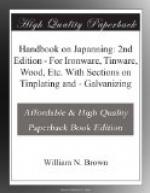powder, stirring it well until the whole is mixed
with the oil. Let the mixture continue to boil
until it appears of a thick consistence, then strain
the whole through a coarse cloth and keep it for use.
The pigments are also sometimes applied in a gum-water
vehicle, but work so done, it has been urged, is not
nearly so durable as that done in varnish or oil.
However, those who formerly condemned the practice
of japanning water-coloured decorations allowed that
amateurs, who practised japanning for their amusement
only and thus might not find it convenient to stock
the necessary preparations for the other methods,
might paint with water-colours. If the pigments
are ground in an aqueous vehicle of strong isinglass
size and honey instead of gum water the work would
not be much inferior to that executed with other vehicles.
Water-colours are sometimes applied on a ground of
gold after the style of other paintings, and sometimes
so as to produce an embossed effect. The pigments
in this style of painting are ground in a vehicle
of isinglass size corrected with honey or sugar-candy.
The body with which the embossed work is raised is
best formed of strong gum water thickened to a proper
consistency with armenian bole and whiting in equal
parts, which, being laid on in the proper figures and
repaired when dry, may be then painted with the intended
pigments in the vehicle of isinglass size or in the
general manner with shellac varnish. As to the
comparative value of pigments ground in water and
ground in oil, that is between oil-colours and water-colours
in enamelling and japanning, there seems to have been
a change of opinion for some time back, especially
as regards the enamelling of slate. The marbling
of slate (to be enamelled) in water-colours is a process
which Mr. Dickson says well repays study. It is
greatly developed in France and Germany. The
process is a quick one and the pigments are said to
stand well and to maintain their pristine hue, yet
if many strikingly natural effects result from the
use of this process, its use has not spread in Great
Britain, being confined wholly and solely to the marbling
of slate (except in the case of wall-paper which is
water-marbled in a somewhat similar way).
“In painting in oil-colour,” says Mr.
Dickson, “the craftsman trusts largely to his
badger-hair brush to produce his effects of softness
and marbly appearance; but in painting in water-colours,
this softness, depth, and marbly appearance are produced
mostly by the colour placed upon the surface, and
left entirely untouched by badger or any other brush.
The colour drying quickly, does not allow much time
for working, and when dry it cannot be touched without
spoiling the whole of the work. The difference
first of all between painting in water and in oil
colour, is that a peculiar grain exists with painting
in water that it is absolutely impossible to get in
oil. The charm of a marble is, I think, its translucency
as much as its beautiful colour; it is to that translucency




